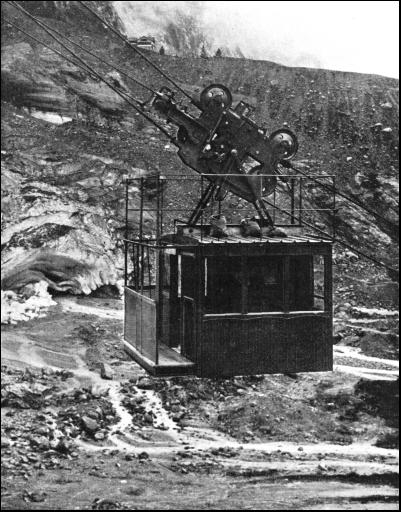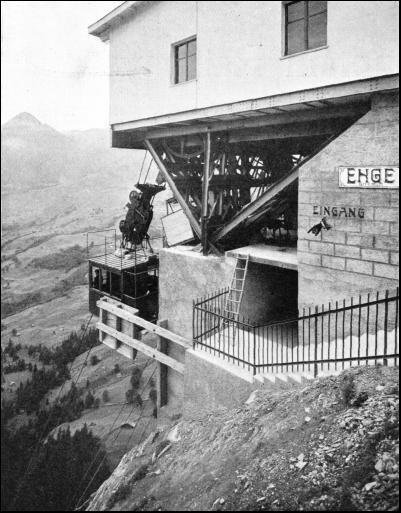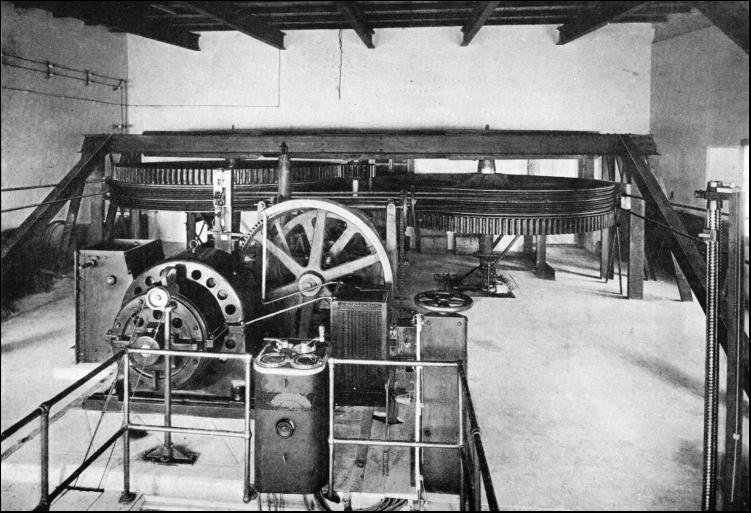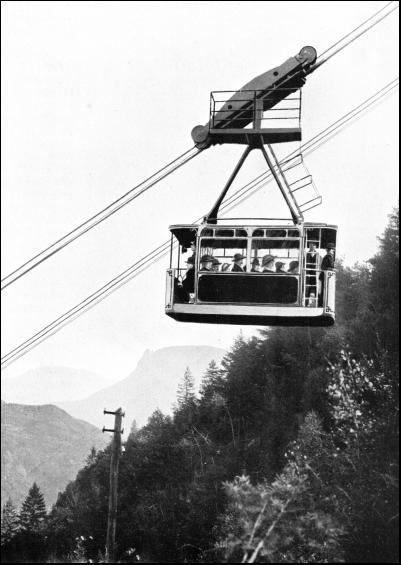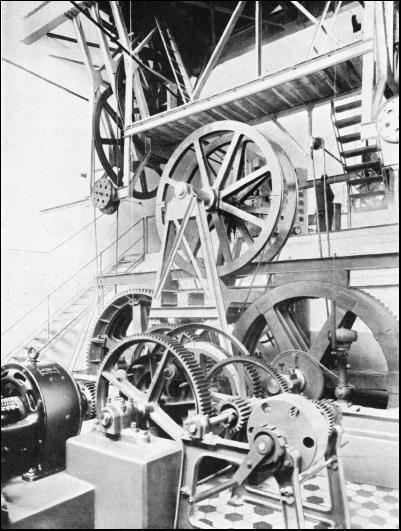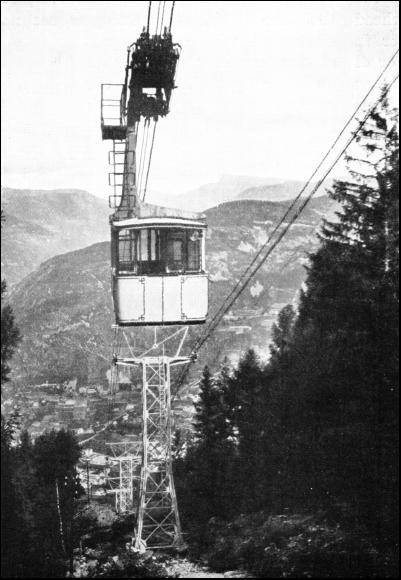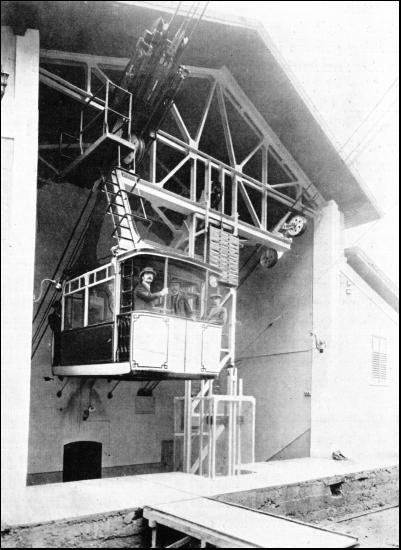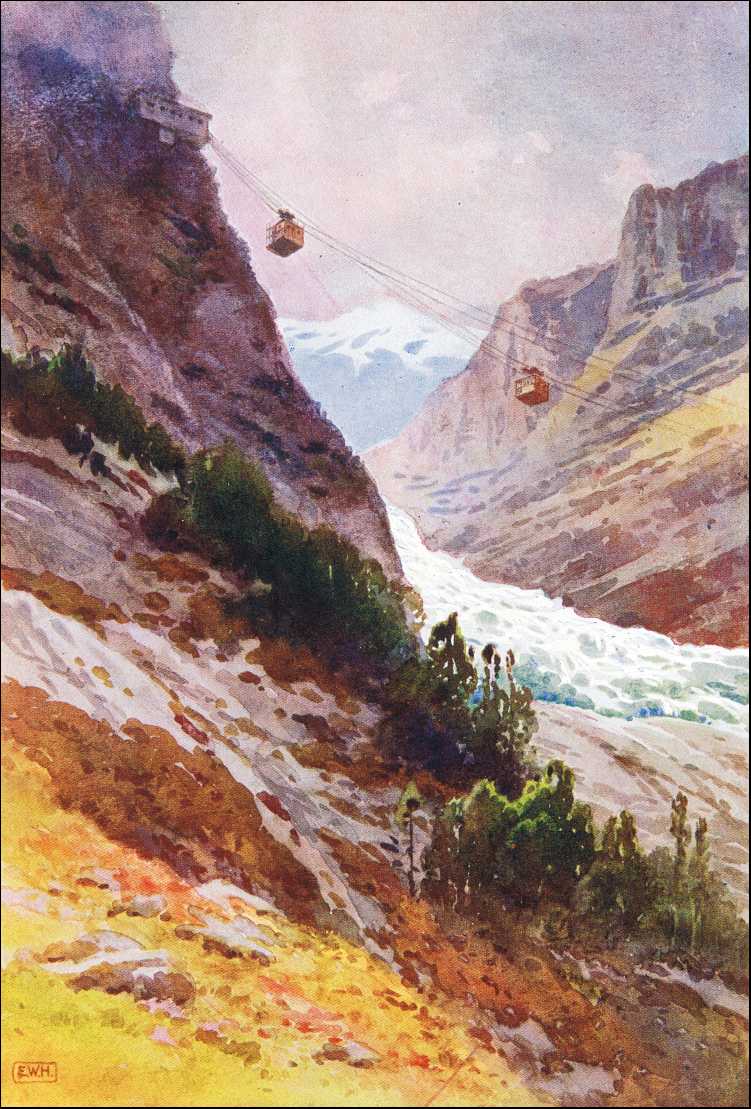By F. A. Talbot |
|
WHILE the cog-wheel railway for the ascent of steep mountains has been brought to a high standard of development, and has been adopted widely during the past forty years, it is somewhat expensive, both as regards first cost and maintenance. The result is that many of the grandest and steepest mountains still are able to defy railway conquest. During the past few years, however, a new system of railway mountaineering has been perfected, and has been brought into practical operation both among the Alps and the American Rockies. This is the aerial railway, wherein the car is slung from a wheeled bogie carriage running along a steel cable stretched through the air. This idea was introduced by a British firm many years ago. The proprietors of a sugar-mill in Hong Kong acquired a site upon the elevated plateau overlooking the coast for the housing of their European staff, the level of the works being somewhat unhealthy. In order to expedite and facilitate movement between the two points, the London firm of Bullivant, which had previously completed several aerial railways for the transport of merchandise, was requested to instal a similar line between the mill and the residential centre. It was completed at a cost of some £5,000, and met the situation very completely.
The line is carried upon lattice steel towers, the track being a single steel rope, along which runs a two-wheeled truck, from which is suspended the travelling carriage, resembling a light double deck seat with the passengers sitting back to back. An endless rope attached to the car hauls it up and down at a maximum speed of 8 miles per hour. Since this pioneer line was built aerial railway travelling has made giant strides. The Hong Kong undertaking is a private concern, so when it came to catering for the public upon similar lines, many questions had to be taken into consideration which did not affect the first-named enterprise. The first public railway of this character, designed essentially for public service, was that up the Wetterhorn, in the Bernese Oberland. The idea was elaborated by Herr Feldmann, who supervised the construction of the Barmen-Elberfeld suspension railway. This engineer evolved an entirely new system, so far as its details were concerned, wherein unassailable security was ensured. He adopted two ropes to form a track, one being placed above the other. There are two tracks, each carrying a car, and as the latter are connected together by the hoisting rope, one ascends while the other descends, thereby securing a certain measure of counterbalancing, as is adopted on the incline railway. By disposing the two ropes, forming a single track, one above the other, and by using a four-wheeled travelling truck having two wheels on each rope, increased stability of the suspended cars—especially in high winds—was obtained. Although this ingenious engineer did not live to see his idea carried into practical application, yet his plans were prepared so completely that they were easy to fulfil. The contract was undertaken by Messrs. Von de Roll, of the Fonderie de Berne, who have made a speciality of mountain railway engineering in all its varied branches. The lower station is situate at an elevation of about 5,500 feet above sea level, while the upper station is 1,380 feet higher and 1,200 feet distant in a horizontal line. The gradient is thus somewhat steep. The track cables are each 1.93 inches in diameter, and are built up of 96 steel wires disposed in five layers around a central wire. The two cables forming a single track are spaced 2-3/4 feet apart, while 26 feet separates the two lines. Each cable weighs 7.4 lb. per foot, and is able to withstand a stress of 154 tons, so that with the estimated maximum load per cable of 13.8 tons there is a very wide margin of safety. The cables are maintained at a constant tension by the aid of a counterweight of 18-1/2 tons in the lower station, arid any weakening of either cable is compensated automatically. Should one cable break, the second is quite strong enough to support the car.
The travelling truck, as already mentioned, is fitted with four wheels and a guide wheel, two running on the upper side of each supporting cable, while the framing ensures the wheels securing a constant grip upon their respective surfaces, so that derailment is impossible. Each truck is coupled to two hoisting cables, 1.14 inches diameter, built up of 90 steel wires woven together in six strands. These cables will withstand a pull of 43 tons before breaking, but in service the strain is only 2-1/2 tons. They are connected to the travelling truck through a cross arm which brings them 5.4 feet apart. The cars are attached to the respective ends of these hoisting cables, which are passed round two winding drums-driven by a 45-horse-power electric motor in the upper station. From the wheeled truck depends the triangular framing from which the car is suspended. The carriage is about 10 feet square and 8 feet in height, with seating capacity for eight passengers and the driver. If required, however, seventeen people can be carried, there being standing space for nine persons. Each car in the empty condition weighs over 4 tons, so that when fully loaded the total weight is well over 5 tons. The safety devices which are incorporated to ensure the security of the passengers are of a very complete character. The travelling truck carries automatically operating brakes. If a hoisting cable should snap the car is arrested immediately, the brake being so powerful that it is able to bring the vehicle to a standstill, when travelling at full speed, within less than one foot. This brake can also be applied by the driver from the car ; but in any event he has to climb to the railed-in roof of the car to reset it before the journey can be resumed.
The driving station also is supplied with numerous devices to the same end. If the electric current supply should fail, the car attain too high a speed, or the machinery reveal some defect, a magnetic brake acts on the winding gear. The engineer is supplied with indicators which reveal the speed and position of the cars on the track throughout the journey. So a car cannot run away. Failure of the electric current from the public supply, however, does not bring the railway to a complete standstill. In the lower station is a secondary battery, which is kept fully charged, and this is able to run the vehicles through twenty-five journeys. Neither can the passengers become stranded on the track midway between the two stations. If the machinery breaks down completely the winding sheaves can be operated by manual effort to bring the cars in. As it is quite possible, although very remote, that a car may come to a standstill along the track owing to some defect developing in its mechanism, there is a small emergency car which can be let down the track to the stalled vehicle to take off the passengers ; this little vehicle can be operated either through a small electric motor or by hand. The cars are suspended from their carrying truck in such a way that they maintain an even deck throughout the journey, irrespective of the inclination of the track. Thus on the uppermost section of the line, where the gradient is exceedingly severe—it is almost vertical—the feeling of being transported in a lift is conveyed, there being no impression of the steepness of the climb, except by taking stock of the surroundings. After being submitted to the most exacting tests by the Swiss authorities, the Wetterhorn Aerial Railway was opened for public service in July, 1908. Since then it has been running continually without the slightest mishap. Herr Josef Staffler, of Bozen, had contemplated a similar conquest of the Kohlerer mountain in the Austrian Tyrol. This peak was provided with a primitive aerial ropeway carried on wooden supports, but under the tourist development of the country it demanded modernisation. Herr Staffler decided to adopt an aerial system as being cheaper, quicker, and more satisfactory, and forthwith discussed the question with Adolf Bleichert and Company, the well-known London and Leipzig firm, who have completed some of the most noteworthy aerial railways of the world. A scheme was evolved, and in this instance, as in Switzerland, the Austrian Government had to be satisfied very completely upon the adequacy of the public safeguards. This aerial railway commences at Eisack, and soars up the mountain side for a distance of 5,250 feet. The distance is not covered in a single span, as in the case of the Wetterhorn line. Twelve lattice steel towers are introduced at intervals to support the track. The latter comprises two steel ropes, each about 1-25/32 inches in diameter, and spaced about 19-1/2 inches apart. There are two tracks, one for each car, the railway being run upon the counter-balancing system. At the upper station the ropes are anchored in the mountain side, while at the lower end they are connected to massive weights, placed in a pit, in order to maintain the tension. There are two hoisting ropes attached to the travelling truck, which is fitted with four wheels, two running on each rope. In this instance the two ropes are placed side by side, instead of one above the other, as in the Wetterhorn railway. The towers supporting the track are of heavy construction, built on massive foundations. Their height varies from 23 to 97-1/2 feet, according to the configuration of the mountain flank. The ropes are carried upon the supporting brackets in such a manner that no jar or oscillation is imparted to the car as its track wheels pass over. The travelling speed is about 10 feet per second, and the complete journey occupies about thirteen minutes.
The railway is electrically operated, and the starting always is carried out from the upper station after the visual and acoustic signals have been transmitted and acknowledged between the two points. Electricity is drawn from a neighbouring generating station. As the railway works upon the counterbalancing system, the additional power required is not very great. An electric motor drives a wheel to which is coupled the cable sheave or pulley, round which the cable is wound several times. Thus the drive is as direct as possible, while three braking systems serve to control the mechanism very adequately. The car itself is suspended from the travelling truck in such a way that it maintains a horizontal position, irrespective of the gradient, and as it is fitted with large plate-glass windows, the sixteen passengers are afforded magnificent uninterrupted views from their seats within. The roof is flat, and means of access to the overhead equipment is afforded for the driver in the event of anything going wrong or of attention to the track and truck being necessary. The suspender is a heavy piece of nickel steel, and the construction thereof, in conjunction with the wheeled truck, is such that it is impossible for the car to fall from the track.
The braking arrangements are of an elaborate character to secure the unquestionable safety of the public. Should a hoisting rope break there is a powerful clip which instantly grips the track, and brings the car to a standstill, the application being automatic. This brake is so powerful that during the builder's trials, when one of the hoisting ropes was broken purposely, the vehicle only slipped back six inches before it came to a stop. Even if one of the track cables broke no alarm need be entertained, as the brake would come into operation instantaneously, and after the car had been stopped it could be restarted and driven slowly into its station along the remaining cable. This brake can be applied also by the driver from within the car in case of emergency, so that no matter what might happen it is impossible for the car to get out of control. At the same time the stations are fitted both with automatic and hand-operating brakes to guard against various contingencies, such as the failure of the electric current, breakdown of the machinery, or of the car, etc. Then there is an accumulator battery, capable of running the railway for several hours continuously should the main supply give out. Even if this broke down while the cars were on the track, they can be wound in by hand, either with the passengers within or after an emergency car has been sent down the track to take off the travellers. Even suppose everything went wrong, and that the cars were brought to a dead standstill, impossible of recovery for the time being, the passengers are not confronted with the prospect of dangling in mid-air for an indefinite period. The car carries an emergency apparatus in the form of a collapsible bag with a rigid bottom. This is lowered through a trap door in the floor, with the passenger standing upright within. There is no danger of a hurried descent to Mother Earth, because the lowering of this apparatus is governed by a braking gear, so that the ground is reached without any perceptible jar. The travelling speed upon the line is restricted very rigorously by the authorities, and expedients have had to be introduced to keep within the prescribed limits. There is a speed regulator which is set to the authorised maximum. Directly the car exceeds this point the automatic brake comes into action and checks the speed. Again, the authorities forbid the operation of the railway during high winds. An anemometer is mounted upon the roof of the upper station, and this is connected to a bell signal. Directly the wind exceeds a certain velocity, to which the apparatus is set, this bell warns the mechanic to suspend the service. As a matter of fact there is no danger of the highest winds imperilling the safety of working, but the regulations of the authorities must be obeyed. Travelling by this aerial railway is marked by the complete absence of vibration and oscillation. The cars start without any perceptible jolt and glide steadily and smoothly up and down the mountain sides. When approaching the station the speed is slackened automatically, and the vehicle is brought gently to rest. In addition to the telephone and electric lighting circuit between the station for the transmission of the audible and visual starting signals, as well as other service communications, a special telephone wire is provided for the convenience of the driver of the car. He is in continuous communication with both stations during the journey, and can notify the engineers at both ends the moment any untoward incident develops. Another aerial passenger railway, working upon a third system, the Ceretti-Tanfani, also has been completed in the Austrian Tyrol, to connect Lana with the summit of the Vigiljoch. While this system has been in operation upon its broad lines for the transportation of goods traffic in various parts of Europe for many years past, this is its first direct application to passenger service. In this instance, also, the Austrian Government proved most exacting in its determination to protect the public. After the line was completed the government engineers subjected it to innumerable tests of all descriptions, submitting the safety devices to the most rigorous and searching trials before they extended the requisite sanction to carry passengers. The line is divided into two sections. The first rises 1,730 feet, while in the second section the difference in level which is overcome is 2,100 feet. Thus there are three stations. The lower terminus contains the tension gear, comprising counterweights aggregating 20 tons, for the lower line, while the uppermost station contains the electrical and other plant. The third is a half-way or change-over house. The counterbalancing system is adopted on both sections of the line, and the cars are suspended pendulum-fashion from the overhead trolley. The cable track comprises one main steel cable-way along which run two two-wheeled trucks mounted in tandem in a frame.
These wheels run along the top face of the cable, but underneath are guard wheels which prevent the trolley jumping the track, so that derailment is absolutely impossible. In addition to the hauling rope whereby the car is drawn to and fro, there is a brake rope on which the automatic brake of the car acts. If the exigencies of traffic demand that two cars shall travel one behind the other, each has its separate hauling rope, but the hauling rope of the leading car acts as the brake rope of the second vehicle, while the hauling rope of the following vehicle acts as the brake rope of the first car. Both these ropes are driven by drums which are operated by a common motor in the upper station, and should a braking rope snap, the car or cars can be braked by hand. This is an ingenious arrangement, and it constitutes one of the outstanding features of the Ceretti-Tanfani patent, the value of which has been emphasised in connection with the official inspection of this railway. It might be anticipated that, when the automatic brake was applied suddenly by the failure of the hauling rope, there might be a tendency for the rear truck wheels to kick, and thus jump the line, but this is impossible owing to the guard wheels. These are kept hard pressed against the carrying rope by means of springs, and are only forced apart as the car glides over the line supports on the towers, the track wheels passing over the upper face of the shoe, while the guard wheels pass beneath it. Directly the car has passed the tower the guard wheels are forced against the track cable once more. Elaborate safety devices of various descriptions to bring the car to a standstill under all conditions of accident to the line are incorporated, and it is virtually impossible to precipitate an accident to the vehicle and its occupants. This aerial railway is one of the longest in existence for the carriage of passengers ; no fewer than 39 lattice steel pyramid towers, ranging from 21 to 100 feet in height, according to the contour of the ground, are required to support the line. Some of the spans are of considerable length, the longest being about 720 feet. Each tower has two arms for supporting the track on either side, and the carrying cable, 2-3/8 inches in diameter, made up of 238 stranded and spirally wound wires, will sustain a pull of 235 tons before breaking. The margin of safety consequently is very ample. The hauling and braking ropes are one half the thickness of the track cable, and have a breaking strain of 58 tons. The foregoing European installations may be described as expressions de luxe in connection with aerial methods of travelling when compared with the "Sunrise Peak Aerial Railway—The World's Grandest Scenic Route," since in this instance the passengers are accommodated in a large bucket ! This line lacks all the finish of its Alpine prototypes, but, on the other hand, it introduces the traveller to most gorgeous scenic attractions. It is about 1-1/2 miles in length, and lifts the sightseer from Silver Plume, at 9,000 feet above sea level, to the summit of Sunrise Peak, 3,500 feet higher.
"To the Clouds in a Bucket" is one of the sensations of Colorado, and it must be admitted that large numbers of people avail themselves of this opportunity to attain one of the eyries of the Rocky Mountains. The railway swings across yawning canyons, and over bleak wind-swept brown humps of the range, in its ever-upward climb. The track comprises a single cable, while propulsion is afforded by the endless haulage cable, 1-1/2 inches in diameter, which passes round a drum at either terminal. The travelling truck is fitted with two wheels each 4 inches in diameter. The track is carried on supports resembling gallows in shape, made of timber members measuring 8 inches square. There are fifty of these towers distributed over the road, the length of the spans varying according to the mountain slope and the lay of the country traversed. The motive power is electricity, drawn from a generating station four miles away, and drives two 35-horse-power motors, coupled to the winding drums, in the upper station. The cars are merely huge buckets, similar to those employed for excavating purposes, and they are slung from the overhead travelling truck. There are 20 buckets on the line, spaced about 485 feet apart. The cars only make a brief stop at the station, and the passengers, in true American fashion, "have to get a move on" to make sure of their seats. Each bucket is strongly made of wrought iron, is 6 feet long by 4 feet wide, and has four seats. The car is entered through a side door, which, when the bucket is loaded, is shut and bolted firmly on the inside. There is no protection from the weather, and should rain be encountered at a higher altitude as though threatening a second deluge, or the sun pour down as if bent upon grilling, the inmates have to suffer in silence unless they have brought suitable conveniences with them. Although there is a conspicuous lack of comfort or luxury upon this line, it has the compensating advantage of giving the traveller a free, open, inspiring view of gulch, peak, snow, cloud, and torrent from an altitude of 12,500 feet. There are five intermediate stations, built around the upper parts of the cable-supporting towers, each complete with its attendant, and the line is equipped with electric signals and telephones. Should any untoward mishap occur during the journey, the station-master can telephone to the engineer to stop the line, and communicate the nature of the accident. This line demanded some three years in its construction, and although undeniably primitive, it involved an outlay of £14,000. It has proved a unique success, the touring public evidently tolerating, imprisonment within a confined space for half-an-hour each way with the utmost good humour. "It is easier than climbing, anyway," comment the patrons of this railway, "and a darn sight quicker !" The success of the aerial railway is so marked that a new era in railway mountaineering has dawned. There is no doubt but that in the future this method of scaling lofty peaks for the benefit of the tourist will undergo considerable development, and will be preferred generally to the cogwheel and incline railways which have had such an extensive vogue. Certainly it will offer a means of carrying passengers to the crests of towering mountains which otherwise would be inaccessible by any other railway system, since no mountain flank is too precipitous for this type of line.
Many thanks for your help
|
   Share this page on Facebook - Share  [email protected] |

